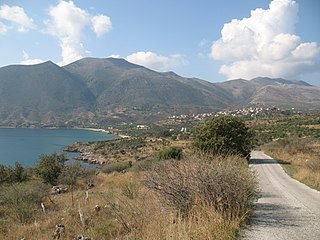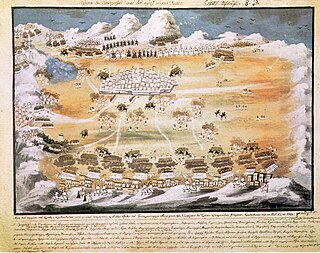Invasion
The Ottomans then headed to Skoutari only to find it abandoned except for the Grigorakos' tower in the centre of the town which was garrisoned by fifteen men under the command of Yanis Katsanos. [3] The Ottomans laid siege to the tower, but were repulsed for the first three days by the small force. On the third night Hasan Ghazi, frustrated by not having captured the tower, had it undermined. Once the mine was completed, he loaded it with gunpowder, which he ignited, killing all the men in the tower.
The Ottoman army then proceeded to the plain between Parasyros and Skoutari which was called 'Agio Pigada' which means 'Holy Wells' because of the monastery on the hill above the plain being surrounded by wells. The Maniot army advance to Parasyros and sent three brothers as envoys to Hasan Ghazi. They demanded that Hasan Ghazi and his men retreat or they would face to fight the Maniot army. Seeing that his army outnumbered than the Maniot army, he responded by beheading the Maniots' envoys and sending their heads to the Maniots on silver plates.
The infuriated Maniot army charged down the hill, and before the Ottomans had a chance to prepare, the Maniots were upon them. The battle ended in a rout with the Ottoman army suffering heavy casualties. The rest of the Ottoman army retreated. The Maniots had nowhere to bury so many corpses, so they threw them down wells. The plain later got the name 'Vromopigada,' which means 'Dirty Wells'.

The Peloponnese, Peloponnesus or Morea is a peninsula and geographic region in southern Greece, and the southernmost region of the Balkans. It is connected to the central part of the country by the Isthmus of Corinth land bridge which separates the Gulf of Corinth from the Saronic Gulf. From the late Middle Ages until the 19th century, the peninsula was known as the Morea, a name still in colloquial use in its demotic form.

The Mani Peninsula, also long known by its medieval name Maina or Maïna, is a geographical and cultural region in the Peloponnese of Southern Greece and home to the Maniots, who claim descent from the ancient Spartans. The capital city of Mani is Areopoli. Mani is the central of three peninsulas which extend southwards from the Peloponnese. To the east is the Laconian Gulf, to the west the Messenian Gulf. The Mani peninsula forms a continuation of the Taygetos mountain range, the western spine of the Peloponnese.

The Orlov revolt was a Greek uprising in the Peloponnese and later also in Crete that broke out in February 1770, following the arrival of Russian Admiral Alexey Orlov, commander of the Imperial Russian Navy during the Russo-Turkish War (1768–1774), at the Mani Peninsula. The revolt, a major precursor to the Greek War of Independence, was part of Catherine the Great's so-called "Greek Plan" and was eventually suppressed by the Ottomans.

Tripoli is a city in the central part of the Peloponnese, in Greece. It is the capital of the Peloponnese region as well as of the regional unit of Arcadia. The homonym municipality had 44,165 inhabitants in 2021.

Petros Mavromichalis, also known as Petrobey, was a Greek general, politician and the leader of the Maniot people during the first half of the 19th century. His family had a long history of revolts against the Ottoman Empire, which ruled most of what is now Greece. His grandfather Georgios and his father Pierros were among the leaders of the Orlov Revolt.

Skoutari is a village and a community of the municipality of East Mani. Before the 2011 local government reform it was a part of the municipality of Gytheio, of which it was a municipal district. The 2011 census recorded 234 residents in the village and 293 residents in the community. The community of Skoutari covers an area of 11.667 km2. According to local tradition it was founded by refugees from the Fall of Constantinople in 1453.
Parasyros is a village of the municipality of East Mani. Before the 2011 local government reform it was a part of the municipality of Gytheio. Parasyros is part of the community of Skoutari. Parasyros is located 2 km west of Skoutari, 9 km east of Areopoli and 13 km southwest of Gytheio.

The Battle of Vromopigada was fought between the Ottoman Turks and the Maniots of Mani in 1770. The location of the battle was in a plain between the two towns of Skoutari and Parasyros. The battle ended in a Greek victory.

The Ottoman–Egyptian invasion of Mani was a campaign during the Greek War of Independence that consisted of three battles. The Maniots fought against a combined Egyptian and Ottoman army under the command of Ibrahim Pasha of Egypt.

The Maniots or Maniates are an ethnic Greek subgroup that traditionally inhabit the Mani Peninsula; located in western Laconia and eastern Messenia, in the southern Peloponnese, Greece. They were also formerly known as Mainotes, and the peninsula as Maina.

The 1815 Ottoman Invasion of Mani was one of a series of invasions by the Ottomans to subdue the Maniots. Mani was the only region of Greece that the Ottomans had not occupied due to the rough terrain and the rebellious spirit of the Maniots. The Maniots caused damage to the Ottomans by allying with the Venetians whenever there was a war between Venice and the Ottomans. They also practiced piracy.

The 1803 Ottoman Invasion of Mani was one of a series of invasions by the Ottomans to subdue the Maniots. Mani was the only region of Greece that the Ottomans had not occupied due to the rough terrain and the rebellious spirit of the Maniots. The Maniots caused damage to the Ottomans by allying with the Venetians whenever there was a war between Venice and the Ottomans; they also were pirates.

The 1807 Ottoman Invasion of Mani was one of a series of invasions by the Ottomans to subdue the Maniots. Mani was the only region of Greece that the Ottomans had not occupied due to the rough terrain and the rebellious spirit of the Maniots. The Maniots caused damage to the Ottomans by allying with the Venetians whenever there was a war between Venice and the Ottomans; they also were pirates.
The siege of Kastania was fought in July 1780 between the Maniots and the klephts under Konstantinos Kolokotronis and Panagiotaros Venetsakis and the Ottoman Empire under Ali Bey.

The siege of Tripolitsa or fall of Tripolitsa, also known as the Tripolitsa massacre, was an early victory of the revolutionary Greek forces in the summer of 1821 during the Greek War of Independence, which had begun earlier that year, against the Ottoman Empire. Tripolitsa was an important target, because it was the administrative center of the Ottomans in the Peloponnese.
The Mavromichalis family is a prominent noble family from Mani Peninsula, which played a major role in modern Greek history.

Liverios Gerakaris, more commonly known by the hypocoristic Limberakis, was a Maniot pirate who later became Bey of Mani.
Konstantinos Kolokotronis was a notable Greek klepht leader in the third quarter of the 18th century in the Peloponnese, and the father of Theodoros Kolokotronis, one of the leaders of the Greek War of Independence.
The Greek Legion, officially the Light Jäger Foot Legion, was a Jäger infantry unit in the service of the Russian-controlled Septinsular Republic. It consisted of soldiers of Greek and Albanian origin and was led by Major-General Emmanouil Papadopoulos. It was active between 1805 and 1807, taking part in the War of the Third Coalition and the Russo-Turkish War (1806–1812).
Tzanetos "Kapetanakis" Grigorakis, also known as Zanetos or Tzanibey or Zanibey or Tzanetbey or Zanetbey, was a Greek politician, general and the 3rd bey of Mani, the most prominent together with Petrobey Mavromichalis. He was the longest-ruling bey of the Maniots, serving for 16 years, from 1782 to 1798.










